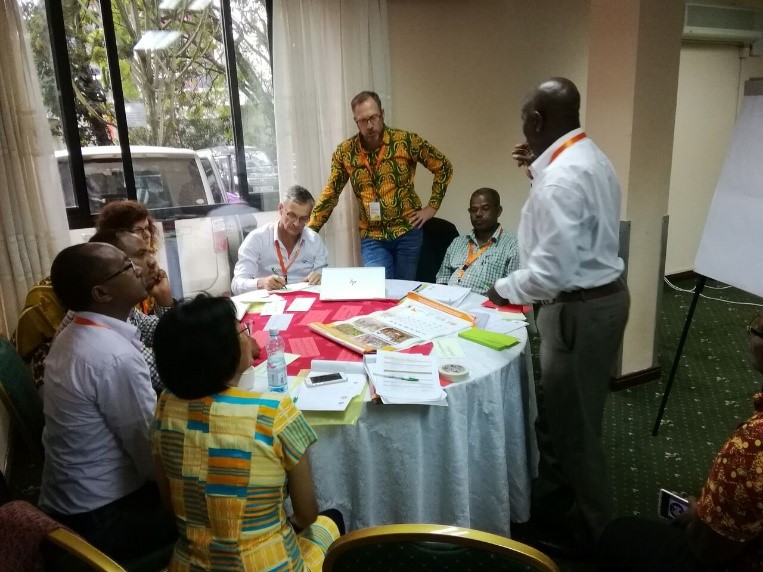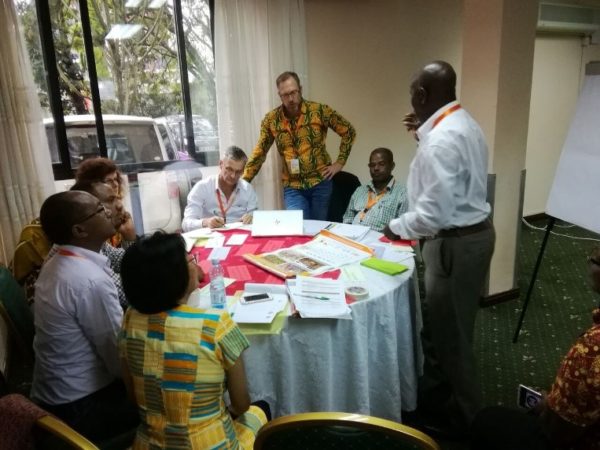Representatives of three teams whose proposals were successfully awarded funds from the CGIAR Research Program on Roots, Tubers and Bananas (RTB) Scaling Fund, along with program leadership and technical experts in scaling, came together in Nairobi, Kenya, in March. The aim of the workshop was to equip the teams with the tools and knowledge needed to plan and implement strategies to take their innovations to scale. Participants left the workshop challenged with new ideas, new ways of addressing challenges to their scaling projects and a better understanding of how to scale up their technologies with the support of the tools provided.
“I want to learn how we can make scaling work responsibly, taking on a systems perspective,” Graham Thiele, RTB Director, responded when asked about his expectations of the meeting. The other participants also agreed that overall, they wanted to learn how to make scaling work and work well.
For the program’s second phase, RTB established a Scaling Fund as a mechanism to foster the scaling of the most promising RTB innovations, generate an evidence base around the scalability of these innovations and improve scaling strategies, approaches and tools. Three promising technologies were awarded grants following a competition selection process: 1) an approach for controlling the banana disease BXW known as single diseased-stem removal (SDSR); 2) a method for conserving sweet potato roots to produce planting material known as Triple S; and 3) a technology for turning cassava peels into an ingredient of animal feed.
During the workshop, Theory of Scaling experts Seerp Wigboldus (Wageningen University & Research) and Murat Sartas (Wageningen University and International Institute of Tropical Agriculture), introduced the participants to the theory of scaling and the tools that support successful scaling up of projects with special focus on the Scaling Readiness tool. Participants worked in groups to identify their project core components and secondary components; assessing their readiness as well as identifying components that may cause challenges in achieving scaling and how to best address them.
At the end of each group work session, a representative of the team presented the group’s discussions to the plenary. Each presentation benefited from rich debate, comments and suggestions.
Below are some thoughts from the participants on their take-aways from the workshop.
Broadening BXW scaling in East and Central Africa project
Boudy van Schagen, Bioversity International
“We find scaling readiness an excellent approach for structuring and making explicit the important elements in bringing a technology to scale. During an August 2017 workshop we had identified two ‘soft’ innovation components that we had classified as complementary innovation components. The two components were related to capacity building of next- and end-users. Reviewing these as a team at this workshop, we realized the necessity of upgrading these to ‘core’ innovations. We had become aware that for scaling to take place it is not possible to separate our technological innovation from relevant social, political, financial and institutional dimensions.”
Cassava peel transformation team on scaling readiness:
Iheanacho Okike, International Institute of Tropical Agriculture
“The scaling readiness tool is certainly a useful one. In unpacking technologies, it enables deep reflections, teasing out and sequencing the ‘hard’ and ‘soft’ components of the technology and envisaging roles and responsibilities of potential partners by disciplinary advantage. In further examining components for scaling readiness and indicating critically constrained ones which could be addressed through substitution, out-sourcing, improvement, relocation or change of goal, the tool further broadens partnership scoping and thought process.”
Triple S Plus:
Margaret McEwan and team, International Potato Center
Germame Garuma (BoANRD, Ethiopia):
“I have now understood that ‘scaling’ is not just about one issue such as the technology or training; it is a package. This includes policy elements, infrastructure (power, ITC) and markets. This means we need to involve other departments, ministries and sectors at the regional level, e.g. Cooperative Management, Trade and Industry.”
Sam Namanda (CIP-Uganda – technical backstopping)
“My thinking has changed. As we worked on the readiness and use tool, it helped us think through our approach to orientate different partners and their roles. However good the technology is, unless we identify the right partners we may not succeed.”
Margaret McEwan (CIP-SSA project lead):
“Systematically unpacking Triple S helped to surface implicit assumptions and started to build a stronger mutual understanding of what the technology was in different country contexts. We worked through the readiness scale and use scale, and this showed us what was the weakest link – which was different for each country.”
Tom van Mourik (CIP Ghana – using video as an extension tool):
“Unpacking and assessing readiness led to two additional innovations: i) what kind of dissemination strategy or delivery channel was required for the videos; ii) adapting our dissemination approach to the structure and approach that scaling partners were already using.”
The next step in this process of scaling is a kick-off planning workshop in country for each project team and their partners using the tools and knowledge acquired from the workshop, to hit the ground running. With the relatively short project timeline of the Scaling Fund, 2 years, it is imperative that the technologies are rolled out effectively and quickly for maximum impact.

